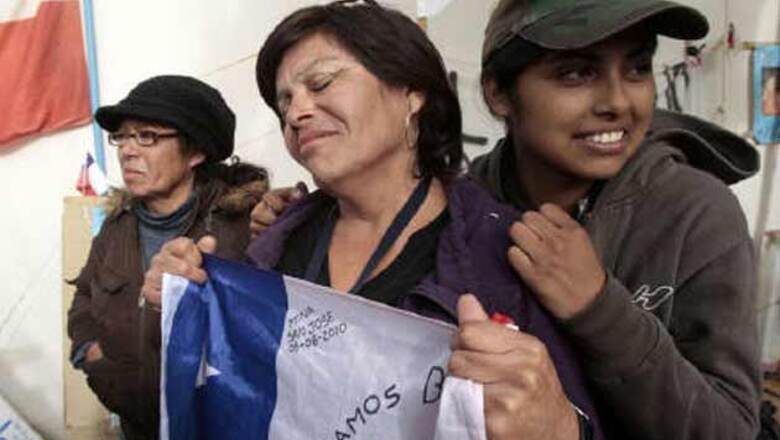
views
Copiapo, Chile: Rescuers in Chile will on Wednesday likely start evacuating 33 miners trapped deep underground for two months after a cave-in, after finishing drilling an escape shaft on Saturday to cheers and tears from relatives on the surface.
Mining Minister Laurence Golborne said rescuers would reinforce only part of a nearly 2,050 foot-long (625-metre) shaft they drilled to free the men from the gold and copper mine, meaning the rescue would begin the middle of next week.
"We hope to start the evacuation process on Wednesday," Golborne told reporters at the mine after briefing jubilant relatives of the miners.
He said the miners staged a controlled explosion down in the mine on Saturday afternoon to clear rock to make room for escape capsules, dubbed Phoenix 1, 2 and 3, to emerge below.
Rescue workers jumped for joy on Saturday morning as the drill pushed through the last inches (cm) of rock into a tunnel nearly half a mile underground. Family members of the miners ran up the hill above the mine waving Chilean flags.
The miners will be hoisted to the surface one at a time in the capsules, just wider than a man's shoulders, in one of the most complex rescue attempts in mining history. The men will be given the same medical checks done on astronauts.
"I'm so happy, I'm going to have my son back!" cried Alicia Campos, whose son, Daniel Herrera, is among those trapped in the mine.
Relatives and friends hugged and kissed as news spread that the shaft was finished. A bell rang out and horns sounded in the tent settlement dubbed "Camp Hope" erected at the mine. Some waved balloons, others sobbed in elation. Champagne corks popped.
Trapped for 65 days so far, the men have set a world record for the length of time workers have survived underground after a mining accident. They are in remarkably good health, although some have developed skin infections.
The men will wear special tinted glasses to avoid damaging their eyes as they emerge into the daylight after their long stay in a tunnel with dim lighting.
"This hell we've been living is almost at an end," said Cristina Nunez, singing and waving a flag as she awaited the rescue of her husband, Claudio Yanez.
Keeping vigil at 'camp hope'
Relatives and friends of the trapped miners have held candlelight vigils at the accident-plagued mine in the far northern Atacama desert since the August 5 collapse, and will stay put at the mine until the men are pulled out.
Among those waiting was weeks-old infant Esperanza, or "Hope," whose father is trapped miner Ariel Ticona. Ticona's wife, Elizabeth, named the child after the makeshift camp at the mine and sent Ticona a video of the birth down the bore hole.
"I'm so happy," she said, pushing Esperanza in a green stroller.
The wives of some miners have been having their hair done in one of the tents set up as a makeshift hairdressing salon, as they prepare to be reunited with their husbands.
Some of the men have sent back to the surface keepsakes of their ordeal including letters, crucifixes and clothes from the tunnel they call "hell."
After the cave-in, engineers initially bored narrow shafts the width of a grapefruit to locate the men. When they were found 17 days after the accident, all still alive, celebrations sprang up across Chile. Rescuers then passed high-energy gels, water and food down the narrow ducts to keep the miners alive.
The government brought in a team of experts from the US NASA space agency to help keep the men mentally and physically fit during the protracted rescue operation. The men had lost an estimated 22 pounds (10 kg) each in the 2 1/2 weeks before they were found alive.



















Comments
0 comment